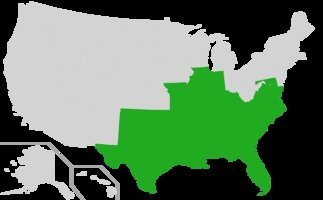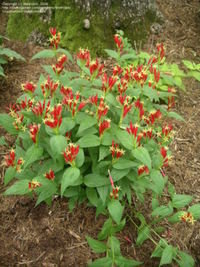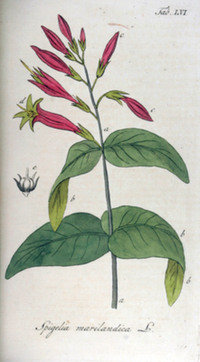





I remember a day last June when Amiable Spouse and I were visiting brother Ronald, who had just purchased a fantastic piece of land just south of Jackson, Mississippi. The fellows were scouting the property, and we girls were reminiscing and cooking up some favorite family recipes. In the midst of it all, Ronald brought a wildflower that he found on the property for me to identify.
I gasped when I saw it, pulled up from the roots and dangling limply in his grasp. "Why did you pull that up?" I wanted to know. "It's one of our most beautiful native wildflowers, and one that you need to encourage on this property." I knew that the flower he so proudly presented for my inspection spread by rhizomes and seeded freely to form colonies in favorable conditions. Obviously he had a native stand of these beauties somewhere on the back forty.
There could be no question about what Ronald held in his hand. It was Spigelia marilandica (Indian pink or Indian pinkroot). The flowers were a dead give-away, for nothing else remotely resembles this attractive member of the Loganiaceae family. The flowers were scarlet and trumpet-shaped, about two inches long, and grew in a spike with all flowers facing one side. At the top they flared open to reveal a yellow lining looking for all the world like a pale yellow star. Leaves were lance-shaped, about 4 inches long, and positioned opposite each other along a wiry stem that stretched to about two feet from root to the tip of the blossom. Leaves without petioles clasped the stems closely.
I was not surprised that Indian pink grew on Ronald's property, for the wildflowers are native to the southeastern United States from zones 5 to 9. His property is laced with rivers and streams and populated with a mixed forest of hardwoods and conifers that provide the growing conditions preferred by this lovely, clump-forming perennial wildflower. 
Culture
Indian pink grows very well in most gardens. It prefers partial to full shade and organically rich, moist but well-drained soils such as that found in well-established woodlands. Once a place is found to its liking, very little maintenance is needed. No diseases or insects are troublesome.
Cuttings are very difficult to root, but plants grow easily from seeds. If you wish to collect seeds, you must watch the ripening seedpods carefully. When the seeds are mature, they burst and send seeds flying all around the area. The seeds should be collected just before the dark brown seedpods are ready to burst. You can sow them directly into garden beds or in pots so that you can keep track of them. The pots will need to winter outside where the seeds can be exposed to nature's varying seasonal temperatures that they need for germination.
Indian pink is very popular with people who wish to attract hummingbirds to their garden. It is number 8 on Operation Rubythroat's list of native plants that attract hummingbirds. Gardeners can plant it at the front of shaded borders or in shade and woodland gardens. 
Other Species
Five other species of Spigelia are listed on the USDA Plants Database. S. gentianoides (purpleflower pinkroot), which is on the Florida and the federal endangered species lists, has a few colonies in three counties in the Florida panhandle and a very limited distribution in Alabama. S. loganioides (Florida or Levy pinkroot) is found in central Florida, and is on the Florida endangered species list. S. anthelmia (West-Indian pinkroot) is found in a few counties in south Florida. Texas pinkroot (S. texana) and prairie pinkroot (S. hedyotidea) can be found in Texas.

Uses
As with many native plants, Spigelia has been used for several medicinal purposes. Native Americans used it to help rid the body of parasitic worms, which accounts for one of its common names, "worm grass." Several other medicinal properties have been ascribed to it, but it should never be ingested without supervision, for it can cause convulsions and even death.
Sources
Of course, while I was in Mississippi, I found a nursery that sold Indian pink. I purchased three plants for my Florida garden. Performance has been less than I hoped as only one of the three plants remain, and it seems to be diminishing in vigor. I will keep trying, and surely a place will be found in my garden that suits it to a tee. Several sources are listed on Dave's Garden Plantscout, and I will start there with renewed hope.
Images by Weerobin and Wikipedia are used with appreciation.Copyright © www.100flowers.win Botanic Garden All Rights Reserved